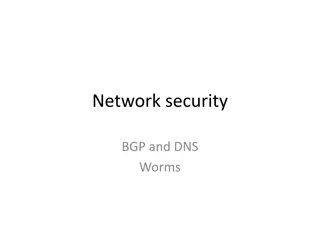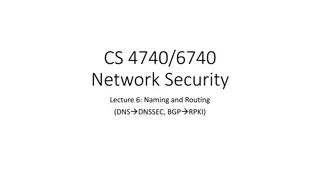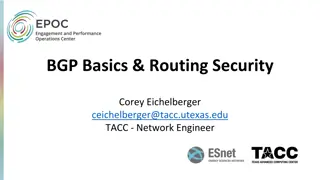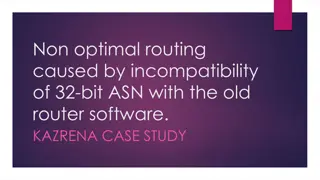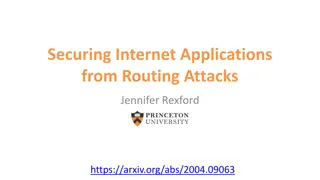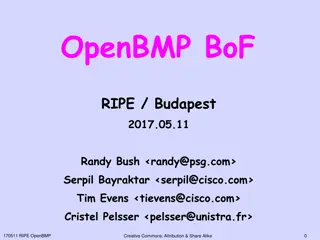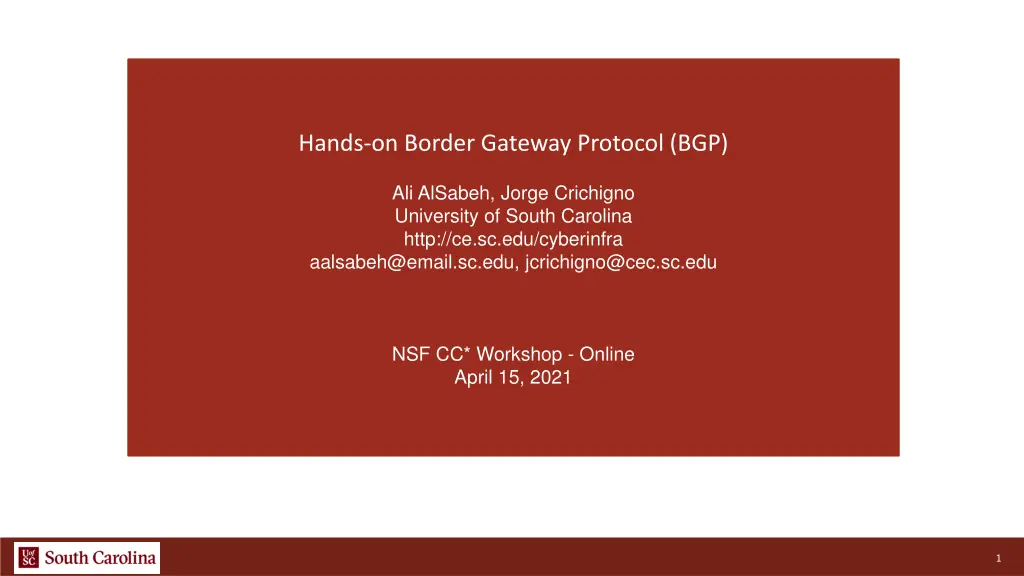
Hands-On BGP Lab Series and FRR Introduction
Dive into the Border Gateway Protocol (BGP) with lab activities covering Mininet, Free Range Routing (FRR), EBGP configuration, BGP authentication, and more. Explore the basics of BGP, the FRR open-source protocol stack, and BGP's best path selection.
Download Presentation

Please find below an Image/Link to download the presentation.
The content on the website is provided AS IS for your information and personal use only. It may not be sold, licensed, or shared on other websites without obtaining consent from the author. If you encounter any issues during the download, it is possible that the publisher has removed the file from their server.
You are allowed to download the files provided on this website for personal or commercial use, subject to the condition that they are used lawfully. All files are the property of their respective owners.
The content on the website is provided AS IS for your information and personal use only. It may not be sold, licensed, or shared on other websites without obtaining consent from the author.
E N D
Presentation Transcript
Hands-on Border Gateway Protocol (BGP) Ali AlSabeh, Jorge Crichigno University of South Carolina http://ce.sc.edu/cyberinfra aalsabeh@email.sc.edu, jcrichigno@cec.sc.edu NSF CC* Workshop - Online April 15, 2021 1
Lab Series: Border Gateway Protocol Lab 1: Introduction to Mininet Lab 2: Introduction to Free Range Routing (FRR) Lab 3: Introduction to BGP Lab 4: Configure and verify EBGP Lab 5: BGP Authentication Lab 6: Configure BGP with Default Route Lab 7: Using AS_PATH BGP Attribute Lab 8: Configuring IBGP and EBGP Sessions, Local Preference, and MED Lab 9: IBGP, Next Hop and Full Mesh Topology Lab 10: BGP Route Reflection 2
Organization of Lab Manuals Each lab starts with a section Overview Objectives Lab topology Lab settings: passwords, device names Roadmap: organization of the lab Section 1 Background information of the topic being covered (e.g., fundamentals of BGP) Section 1 is optional (i.e., the reader can skip this section and move to lab directions) Section 2 n Step-by-step directions 3
Introduction to FRR Lab activities are described in Lab 2, BGP Lab Series 4
What is FRR? FRR is an open source routing protocol stack1 The configuration is similar to other vendors Command-line shell and configuration file Protocols are implemented as independent processes Zebra is the process that controls the routing information base (RIB) Command-line interface vtysh Protocol daemons bgpd ripd ospfd Service daemon Zebra (RIB) 1FRRouting website, https://frrouting.org 5
BGP Best Path The main goal is to provide interdomain routing BGP selects one path as the best path It places the selected path in its routing table and propagates the path to its neighbors Is this the best path? Does it meet the path selection criteria? If so, add to routing table. BGP Update BGP Table Routing Table Network Network Slide credits: Rick Graziani, Implementing Cisco IP Routing, Cisco Press, 2015 7 Buffer Sizing
BGP Best Path 1. Prefer the path with largest weight (configured locally; set to 0 (default) for routes not originated by this router) 2. If weights are the same, prefer the path with largest local preference (set to 100 by default) 3. If the local preferences are the same, prefer the path that was originated by BGP running on this router 4. If no route was originated, prefer the route that has the shortest AS_path 5. If paths have the same AS_path length, prefer the path with the lowest origin type (IGP is lower than EGP, and EGP is lower than Incomplete. Prefer routes introduced with the network command over redistributed) 6. If the origin codes are the same, prefer the path with the lowest MED attribute (set to 0 by default) 7. If the paths have the same MED, prefer the external path over the internal path 8. If the paths are still the same, prefer the path through the closest IGP neighbor 9. Prefer the path with the lowest IP address, as specified by the BGP router ID Without route manipulation, the most common reason for path selection is Step 4 If a network administrator does not like the path with fewest ASes, he/she can manipulate weight or local preference to change which outbound path BGP selects Rick Graziani, Implementing Cisco IP Routing, Cisco Press, 2015 8 Buffer Sizing
Configuring IBGP and EBGP Sessions, Local Preference, and MED Lab activities are described in Lab 8, BGP Lab Series 9
The Local Preference Attribute A well-known discretionary attribute Indicates to routers in the AS which path is preferred to exit the AS (higher is better) Configured on a router Exchanged only among routers within the same AS (passed only via IBGP not via EBGP) Default value on a Cisco/FRR router is 100 Local Preference takes precedence over AS_PATH 172.16.0.0 EBGP IBGP EBGP Rick Graziani, Implementing Cisco IP Routing, Cisco Press, 2015 10 Buffer Sizing
The Local Preference Attribute AS 64520 receives updates about network 172.16.0.0 from two directions: via AS 65500 (65500, 65350) via AS 65000 (65000, 65250, 65350) Local preference: On Router A for network 172.16.0.0 is 200 On Router B for network 172.16.0.0 is 150 Local preference information is exchanged within AS 64520 via IBGP All traffic in AS 64520 addressed to network 172.16.0.0 is sent to Router A as an exit point from AS 64520 172.16.0.0 My Local Preference is higher so I am the preferred exit point. IBGP Rick Graziani, Implementing Cisco IP Routing, Cisco Press, 2015 11 Buffer Sizing
Lab 8 Topology Configure OSPF as Internal Gateway Protocol (IGP) in AS 200 Configure BGP as External Gateway Protocol (EGP) 12
Lab 8 Topology Configure LOCAL_PREF and MED attributes to favor the primary link over the secondary one Primary link Secondary link 13
BGP Table Version Internal version number of the table This number is incremented whenever the table changes Router r3 14
Status Code The status is displayed at the beginning of each line in the table Code Meaning s Table entry is suppressed Router r3 d Table entry is dampened h Table entry history * Table entry is valid > Table entry is the best entry to use for this network i Table entry was learned via an internal BGP session r Table entry is a RIB-failure S Table entry is stale = Table entry has multipath to use for this network b Table entry has a backup path to use for this network x The table entry has a best external route to use for this network 15
Next-hop Attribute A well-known mandatory attribute Indicates the next-hop IP address that is to be used to reach a destination Unlike IGPs, BGP routes AS by AS, not router by router The default next-hop is the next AS The next-hop address for a network from another AS is an IP address of the entry point of the next AS along the path to that destination network BGP table router r1 16 Buffer Sizing
The Local Preference Attribute A well-known discretionary attribute Indicates to routers in the AS which path is preferred to exit the AS (higher is better) Configured on a router Exchanged only among routers within the same AS (passed only via IBGP not via EBGP) Default value on a Cisco/FRR router is 100 Local Preference takes precedence over AS_PATH 172.16.0.0 IBGP Rick Graziani, Implementing Cisco IP Routing, Cisco Press, 2015 17 Buffer Sizing
The Local Preference Attribute AS 64520 receives updates about network 172.16.0.0 from two directions: via AS 65500 (65500, 65350) via AS 65000 (65000, 65250, 65350) Local preference: On Router A for network 172.16.0.0 is 200 On Router B for network 172.16.0.0 is 150 Local preference information is exchanged within AS 64520 via IBGP All traffic in AS 64520 addressed to network 172.16.0.0 is sent to Router A as an exit point from AS 64520 172.16.0.0 My Local Preference is higher so I am the preferred exit point. IBGP Rick Graziani, Implementing Cisco IP Routing, Cisco Press, 2015 18 Buffer Sizing
The AS-Path Attribute Well-known mandatory attribute Whenever a route update passes through an AS, the AS number is prepended to that update Router A: advertises network 192.168.1.0 in AS 64520. Router C: prepends its own AS number to it and advertises the route to Router B Router B: From Router B s perspective, the path to reach 192.168.1.0 is: 65500, 64520 My path to 192.168.1.0 is (65500, 64520) Rick Graziani, Implementing Cisco IP Routing, Cisco Press, 2015 19 Buffer Sizing
Origin Attribute A well-known mandatory attribute Defines the origin of the path information The origin attribute can be one of three values: IGP ( i ) The route is interior to the originating AS Normally when the network command is used EGP ( e ) The route is learned via EGP EGP is legacy and no longer supported Incomplete ( ? ) The route s origin is unknown / some other means It usually occurs when a route is redistributed into BGP BGP table router r1 20 Buffer Sizing
Administrative Distance A router may run multiple routing protocols / static routes if BGP and OSPF are configured on a router, both protocols may provide different best paths (analogous to google-maps and mapquest) How does the router know which protocol to choose? The route with lower Administrative Distance is installed in the routing table Router r3 21
The Med Attribute An optional nontransitive attribute, also called metric Indicates to external neighbors the preferred path into an AS By default, a router compares the MED only for paths from neighbors in the same AS. Lowest Wins! MED is sent to EBGP peers: Those routers propagate the MED within their AS But do not pass it on to the next AS 172.20.0.0 Rick Graziani, Implementing Cisco IP Routing, Cisco Press, 2015 22 Buffer Sizing
The Med Attribute Router B has set the MED to 150 for 172.20.0.0 Router C has set the MED to 200 for 172.20.0.0 Router A receives EBGP updates from routers B and C Chooses Router B as the best next hop to get to AS 65500 because of the lower MED 172.20.0.0 My MED is 150 for 172.20.0.0 so send those packets this way. My MED is 200 for 172.20.0.0 so send those packets this way. Which path is most attractive? Rick Graziani, Implementing Cisco IP Routing, Cisco Press, 2015 23 Buffer Sizing
The Weight Attribute Configured locally and not propagated to any other routers Higher weight is preferred Weight takes precedence over Local Preference Value from 0 to 65535 Default is 32768 Default is 0 for routes not originated by this router 26
The Weight Attribute Router A has two ways to reach 172.20.0.0 via Router B (AS 65000) via Router C (AS 65500) Router A is configured to set the weight of updates coming from: Router B to 200 Router C to 150 Weight for Router B is higher, so Router A uses Router B as a next hop to reach 172.20.0.0 Rick Graziani, Implementing Cisco IP Routing, Cisco Press, 2015 27
MED attribute The MED attribute indicates to external neighbors the preferred path into an AS It is used when there are multiple entry points to the same AS The BGP route with the lowest MED value is preferred AS 200 r3 AS 100 MED = 10 MED = 20 r1 r2 Packet destined to router r2 in AS 200 28
BGP Table Example BGP Table BGP table router r1 29 Buffer Sizing
BGP attributes When advertising a prefix, A BGP router includes attributes Attributes help BGP select the best path 30
LOCAL_PREF attribute The LOCAL_PREF attribute is advertised among Internal BGP (IBGP) routers It indicates the preferred path to external Autonomous Systems (ASes) when an AS has multiple routes to another AS The BGP route with the highest LOCAL_PREF value is preferred AS 200 r3 AS 100 LOCAL_PREF = 110 LOCAL_PREF = 120 r1 r2 Packet destined to router r3 in AS 200 31

